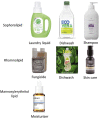Sustainable biosurfactant production from secondary feedstock-recent advances, process optimization and perspectives
- PMID: 38312346
- PMCID: PMC10834756
- DOI: 10.3389/fchem.2024.1327113
Sustainable biosurfactant production from secondary feedstock-recent advances, process optimization and perspectives
Abstract
Biosurfactants have garnered increased attention lately due to their superiority of their properties over fossil-derived counterparts. While the cost of production remains a significant hurdle to surpass synthetic surfactants, biosurfactants have been anticipated to gain a larger market share in the coming decades. Among these, glycolipids, a type of low-molecular-weight biosurfactant, stand out for their efficacy in reducing surface and interfacial tension, which made them highly sought-after for various surfactant-related applications. Glycolipids are composed of hydrophilic carbohydrate moieties linked to hydrophobic fatty acid chains through ester bonds that mainly include rhamnolipids, trehalose lipids, sophorolipids, and mannosylerythritol lipids. This review highlights the current landscape of glycolipids and covers specific glycolipid productivity and the diverse range of products found in the global market. Applications such as bioremediation, food processing, petroleum refining, biomedical uses, and increasing agriculture output have been discussed. Additionally, the latest advancements in production cost reduction for glycolipid and the challenges of utilizing second-generation feedstocks for sustainable production are also thoroughly examined. Overall, this review proposes a balance between environmental advantages, economic viability, and societal benefits through the optimized integration of secondary feedstocks in biosurfactant production.
Keywords: biorefinery; biosurfactant; glycolipid; secondary feedstock; sustainability; valorization.
Copyright © 2024 Miao, To, Siddiqui, Wang, Lodens, Chopra, Kaur, Roelants and Lin.
Conflict of interest statement
Authors SL and SR were employed by Bio Base Europe Pilot Plant. The remaining authors declare that the research was conducted in the absence of any commercial or financial relationships that could be construed as a potential conflict of interest.
Figures





Similar articles
-
Glycolipid Biosurfactants in Skincare Applications: Challenges and Recommendations for Future Exploitation.Molecules. 2023 May 31;28(11):4463. doi: 10.3390/molecules28114463. Molecules. 2023. PMID: 37298939 Free PMC article. Review.
-
Biological machinery for the production of biosurfactant and their potential applications.Microbiol Res. 2024 Aug;285:127765. doi: 10.1016/j.micres.2024.127765. Epub 2024 May 17. Microbiol Res. 2024. PMID: 38805980 Review.
-
Recent advances and discoveries of microbial-based glycolipids: Prospective alternative for remediation activities.Biotechnol Adv. 2023 Nov;68:108198. doi: 10.1016/j.biotechadv.2023.108198. Epub 2023 Jun 15. Biotechnol Adv. 2023. PMID: 37330152 Review.
-
Current status in biotechnological production and applications of glycolipid biosurfactants.Appl Microbiol Biotechnol. 2016 Dec;100(24):10265-10293. doi: 10.1007/s00253-016-7980-z. Epub 2016 Nov 14. Appl Microbiol Biotechnol. 2016. PMID: 27844141 Review.
-
Glycolipid and Lipopeptide Biosurfactants: Structural Classes and Characterization-Rhamnolipids as a Model.Crit Rev Anal Chem. 2024 Dec 29:1-21. doi: 10.1080/10408347.2024.2441428. Online ahead of print. Crit Rev Anal Chem. 2024. PMID: 39734093 Review.
Cited by
-
Production and Optimization of Biosurfactant Properties Using Candida mogii and Licuri Oil (Syagrus coronata).Foods. 2024 Dec 13;13(24):4029. doi: 10.3390/foods13244029. Foods. 2024. PMID: 39766972 Free PMC article.
-
Strategies for the Transformation of Waste Cooking Oils into High-Value Products: A Critical Review.Polymers (Basel). 2025 Jan 29;17(3):368. doi: 10.3390/polym17030368. Polymers (Basel). 2025. PMID: 39940569 Free PMC article. Review.
-
Strawberry Tree Fruit Residue as Carbon Source Towards Sustainable Fuel Biodesulfurization by Gordonia alkanivorans Strain 1B.Molecules. 2025 May 13;30(10):2137. doi: 10.3390/molecules30102137. Molecules. 2025. PMID: 40430310 Free PMC article.
-
Lactobacillus-Derived Biosurfactants: Emulsification and Antioxidant Properties in Oil Emulsions.Food Sci Nutr. 2025 Jun 5;13(6):e70334. doi: 10.1002/fsn3.70334. eCollection 2025 Jun. Food Sci Nutr. 2025. PMID: 40475977 Free PMC article.
-
Microbial communities in petroleum refinery effluents and their complex functions.Saudi J Biol Sci. 2024 Jul;31(7):104008. doi: 10.1016/j.sjbs.2024.104008. Epub 2024 May 6. Saudi J Biol Sci. 2024. PMID: 38766506 Free PMC article. Review.
References
-
- Aghaei S., Saghandali F., Baghban Salehi M., Mokhtarani B., Taghikhani V., Saviz S. (2023). A micromodel investigation on the flooding of glycolipid biosurfactants for enhanced oil recovery. Geoenergy Sci. Eng. 230, 212219. 10.1016/j.geoen.2023.212219 - DOI
-
- Agrawal R., Bhagia S., Satlewal A., Ragauskas A. J. (2023). Urban mining from biomass, brine, sewage sludge, phosphogypsum and e-waste for reducing the environmental pollution: current status of availability, potential, and technologies with a focus on LCA and TEA. Environ. Res. 224, 115523. 10.1016/j.envres.2023.115523 - DOI - PubMed
-
- Ahmar Siddiqui M., Parnthong J., Kungsanant S., Chavadej S., Chaiprapat S. (2022). Influences of specific surfactant structures on biohydrogen production from oily wastewater in batch and continuous anaerobic dark fermentation. Bioresour. Technol. 360, 127617. 10.1016/j.biortech.2022.127617 - DOI - PubMed
Publication types
LinkOut - more resources
Full Text Sources

